The ADATA Ultimate SU800 SSD Review (128GB, 256GB, 512GB)
by Billy Tallis on February 1, 2017 12:01 PM ESTRandom Read Performance
The random read test requests 4kB blocks and tests queue depths ranging from 1 to 32. The queue depth is doubled every three minutes, for a total test duration of 18 minutes. The test spans the entire drive, which is filled before the test starts. The primary score we report is an average of performances at queue depths 1, 2 and 4, as client usage typically consists mostly of low queue depth operations.

Random read performance on the SU800 is typical for budget SSDs, with only the Samsung 750 EVO standing out from the crowd.
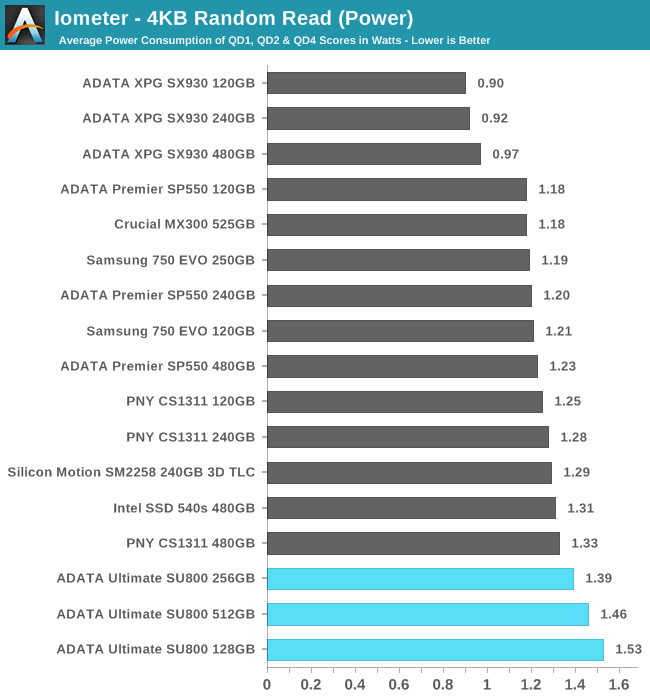
Power consumption during this test is a bit higher than the competition, making the SU800 a relatively inefficient drive, though it's not a severe problem.
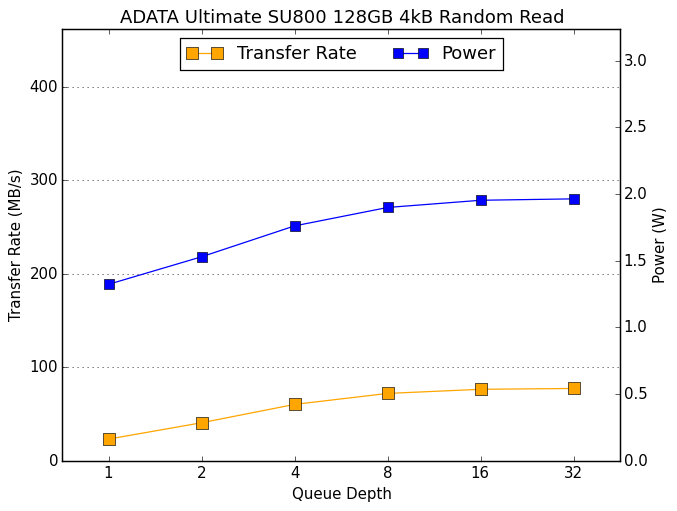 |
|||||||||
With only three flash chips, it's no surprise that the 128GB SU800 shows very little performance increase from higher queue depths in the second half of the test. The larger capacities show more normal scaling behavior.
Random Write Performance
The random write test writes 4kB blocks and tests queue depths ranging from 1 to 32. The queue depth is doubled every three minutes, for a total test duration of 18 minutes. The test is limited to a 16GB portion of the drive, and the drive is empty save for the 16GB test file. The primary score we report is an average of performances at queue depths 1, 2 and 4, as client usage typically consists mostly of low queue depth operations.
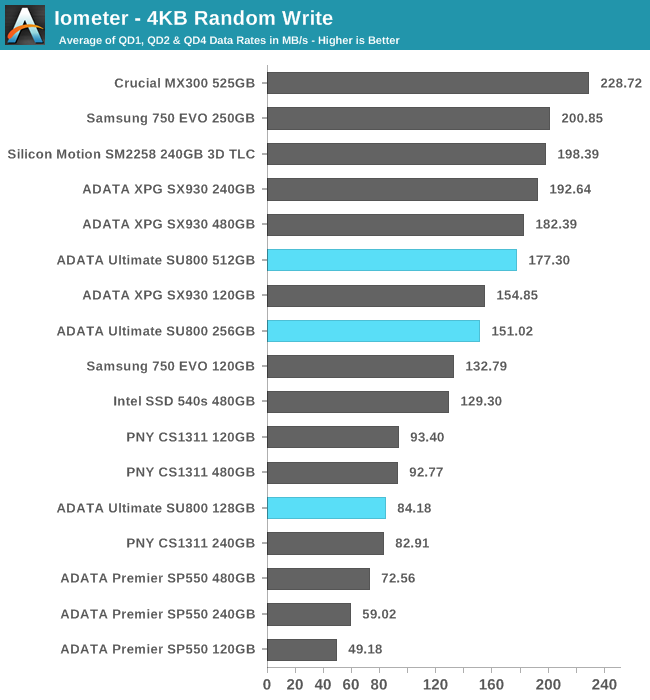
As with the long-running random write consistency test, the Samsung and Crucial drives show the best random write speeds, but the SU800 outperforms most of the planar TLC competition.
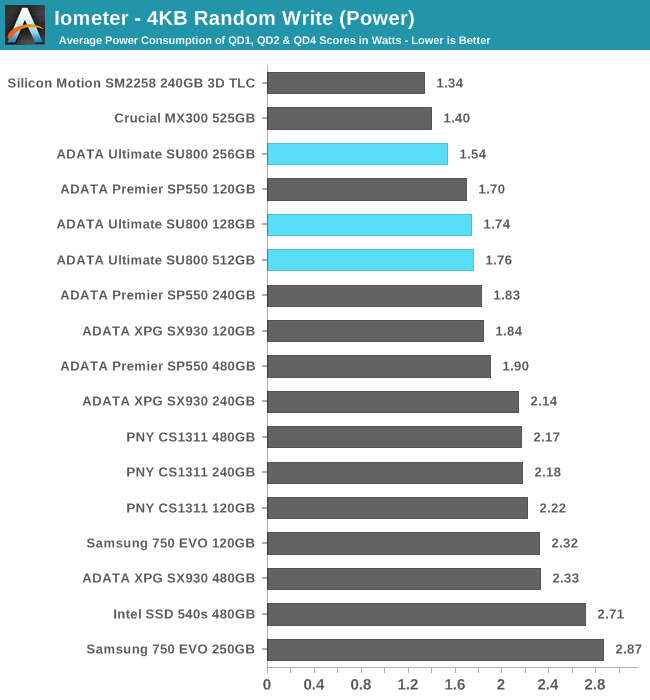
Unlike the random read test, the SU800's power consumption on the random write test is relatively good, though its efficiency is still well behind the Crucial MX300.
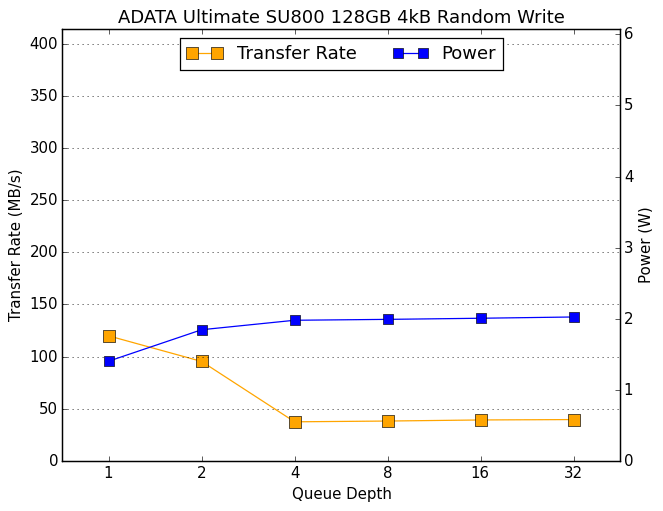 |
|||||||||
The graphs of performance over the course of this test clearly show performance of the smaller two capacities dropping as the SLC cache is filled, and flat performance thereafter. The 512GB SU800's performance in the second half of the test is quite variable due to the garbage collection cycles but on average is decent and certainly better than the planar TLC competitors.










35 Comments
View All Comments
SaolDan - Wednesday, February 1, 2017 - link
Neat!!!MrSpadge - Wednesday, February 1, 2017 - link
Overall a worse deal than the MX300, which itself took quite some criticism. Could you elaborate on what's "neat" about this?vladx - Wednesday, February 1, 2017 - link
Price is low for decent performance. This is SATA SSD targeted towards low end and mainstream market.Great_Scott - Wednesday, February 1, 2017 - link
The MX300 is better value given the drive sizes. I'm still trying to find a replacement for the Mushkin Reactor for desktops, but the Crucial drive is my go-to for laptops currently.Arbie - Wednesday, February 1, 2017 - link
Why do you guys continually fail to mention the Mushkin Reactor 1TB MLC drive ($240 at Newegg) in your SSD comparisons? It's cheaper, faster, and probably has greater endurance.You reviewed it two years ago but have hardly mentioned it since then. It seems to be a "best buy" still.
http://www.anandtech.com/show/8949/mushkin-reactor...
But... kudos on the clickbait. You have at least as much as any other site, and of the lowest degree.
vladx - Wednesday, February 1, 2017 - link
Because Mushkin already refreshed their SSD line and the old Reactor is not manufactured anymore which means it will be gone any week now.Great_Scott - Wednesday, February 1, 2017 - link
And we will all be sad to see it go. I have a bunch of those drives, myself.Flunk - Wednesday, February 1, 2017 - link
They don't often put 2 year old drives in comparisons.Great_Scott - Wednesday, February 1, 2017 - link
That's too bad, as some context would be useful, especially considering that many people own that drive, and until recently it was still being made.Then again, a two-year-old budget drive with a very similar controller would have made the SU800 series look terrible, and we can't have that.
eek2121 - Wednesday, February 1, 2017 - link
The Mushkin Reactor is a drastically slower drive, costs about the same, and will soon disappear from retailers. It is not a competitor.